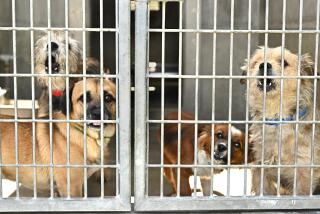Project pairs puppies with panhandlers to combat homelessness
SAN FRANCISCO — A plan to combat panhandling and animal shelter overcrowding in one fell swoop could be described as killing two birds with one stone. But here in the city of St. Francis, no one talks about offing our feathered friends.
Instead, the latest municipal innovation — which will pair beggars with problem puppies to make life better for both — is simply called WOOF: Wonderful Opportunities for Occupants and Fidos.
In August, carefully selected dogs from the city shelter will be given to screened and trained formerly homeless people, who will foster the animals until permanent homes can be found.
The temporary guardians (the words “pet” and “owner” are frowned upon here) will receive a weekly stipend of $50 to $75 and must agree to jettison their cardboard signs. The pilot project is believed to be the first of its kind in the country.
“I can’t make panhandling go away,” said Bevan Dufty, one of the plan’s architects. “But I can make a better offer.”
Dufty is San Francisco’s director of HOPE — Housing Opportunity, Partnerships and Engagement. A former county supervisor, he proposed that the city hire life coaches for its transit drivers when he ran (unsuccessfully) for mayor in 2011.
His latest plan addresses two serious problems in a dog-loving city that prides itself on creativity and heart.
In a tourism bureau survey released last year, 25% of visitors polled said their biggest complaint about the city was encountering the homeless people and panhandlers — eclipsing responses about the weather and traffic.
And since the nation’s economic recession began, said Rebecca Katz, director of Animal Care and Control, the city-run shelter has seen a significant jump in abandoned dogs. The facility took in 2,424 dogs last year, compared with 1,939 in the 2008 fiscal year, Katz said.
“We find ourselves euthanizing dogs that in the past might have gone to rescue,” said Katz, who created the plan with Dufty. “We give them a lot more time than any other shelter I know of in the state or country. Still, there comes a limit.”
Three kinds of dogs, Katz said, will be targeted for the effort: fearful ones that need more socialization time than shelter staff and volunteers can give them; “rowdy” ones that need to learn basic manners; and puppies that cannot be adopted until they are old enough to spay or neuter.
No dogs with a history of fighting or aggression can take part.
As for the temporary guardians, no one with severe mental illness or a history of violence can participate, Katz said, and “no drug or alcohol addiction, unless they’re in treatment.” Anyone using the foster dog as a panhandling prop will be ejected from the program.
The final requirement is that the dog caretakers must have a place to live, which is where Community Housing Partnership comes in. The organization develops and operates permanent supportive housing for formerly homeless people and has 1,000 units throughout the city.
Chief executive Gail Gilman said her housing organization will partner with Animal Care and Control in the pilot effort. Residents who have completed a job readiness program will be eligible. Learning to care for animals, Gilman said, will give clients marketable skills — and more.
“This has a huge potential to be a pathway for many individuals to learn some skills and supplement their income in a more positive, productive way,” Gilman said. “And we know that caring for animals is incredible for individuals who have been isolated and disenfranchised from society.”
Matt Traywick and his dachshund-bichon mix have become the poster family for Katz and Dufty’s plan.
Traywick moved to San Francisco from Washington, D.C., in 2002 for a job. But soon after his arrival, the company folded. He spent the next year and a half living on the streets before moving into a single-room-occupancy hotel called the Empress.
“I thought it was a place where I could take a breath and start over,” Traywick said, but he was not prepared for the loneliness. “When you’re homeless, you stand in line for breakfast, lunch and dinner. You’re constantly around people. When you move back inside … you find yourself totally alone.”
Traywick’s psychiatrist prescribed a service dog, and in January 2011 he met Charlie at Katz’s shelter. The little dog was scraped up and fearful. At first, Traywick thought he was deaf.
But Traywick saved Charlie’s life, and the fluffy white dog returned the favor.
The plan “took a couple days to grow on me,” said Traywick, 52. “When it first hits you, you go, ‘Oh, yeah, another San Francisco idea.’ … But we have a need here. There’s a problem with panhandling. And if one dog like Charlie spends one less scary night at a shelter, it’s worth it.”
More to Read
Start your day right
Sign up for Essential California for news, features and recommendations from the L.A. Times and beyond in your inbox six days a week.
You may occasionally receive promotional content from the Los Angeles Times.







